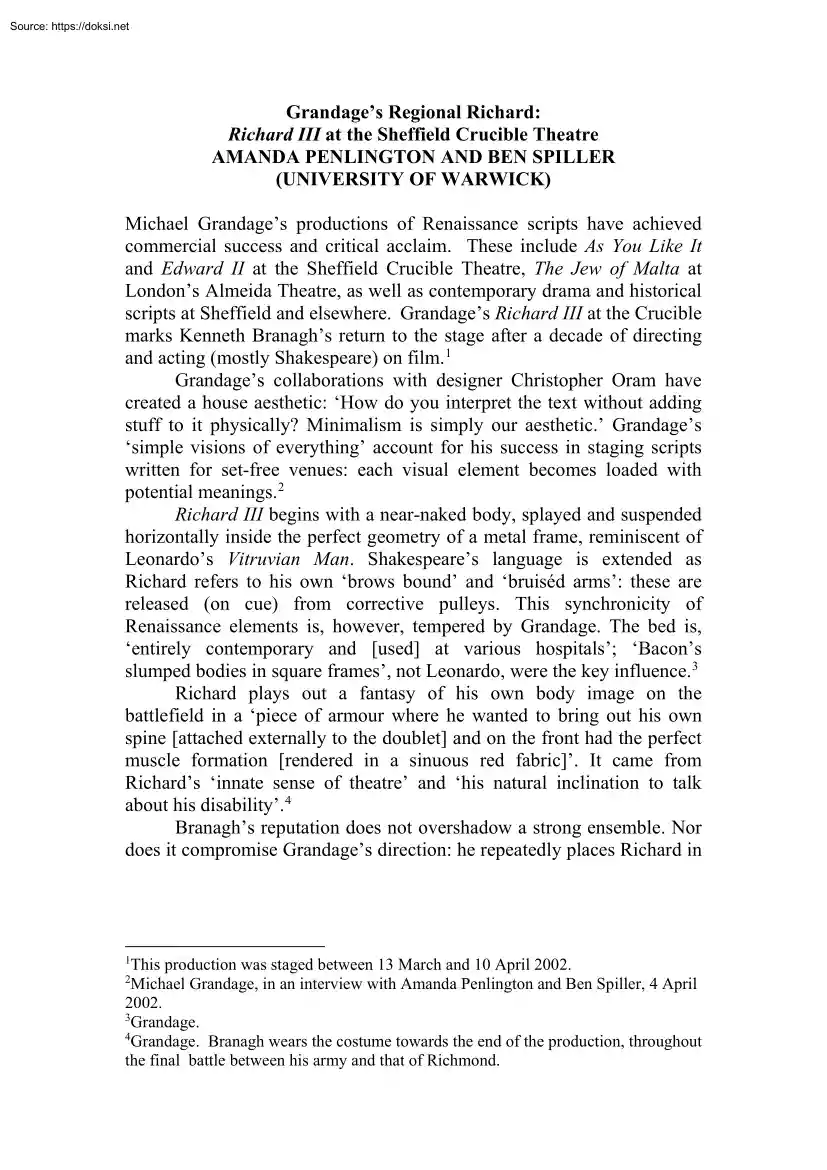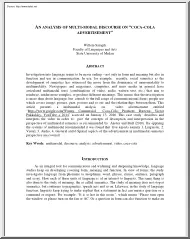Please log in to read this in our online viewer!

Please log in to read this in our online viewer!
No comments yet. You can be the first!
What did others read after this?
Content extract
Grandage’s Regional Richard: Richard III at the Sheffield Crucible Theatre AMANDA PENLINGTON AND BEN SPILLER (UNIVERSITY OF WARWICK) Michael Grandage’s productions of Renaissance scripts have achieved commercial success and critical acclaim. These include As You Like It and Edward II at the Sheffield Crucible Theatre, The Jew of Malta at London’s Almeida Theatre, as well as contemporary drama and historical scripts at Sheffield and elsewhere. Grandage’s Richard III at the Crucible marks Kenneth Branagh’s return to the stage after a decade of directing and acting (mostly Shakespeare) on film. 1 Grandage’s collaborations with designer Christopher Oram have created a house aesthetic: ‘How do you interpret the text without adding stuff to it physically? Minimalism is simply our aesthetic.’ Grandage’s ‘simple visions of everything’ account for his success in staging scripts written for set-free venues: each visual element becomes loaded with potential meanings. 2
Richard III begins with a near-naked body, splayed and suspended horizontally inside the perfect geometry of a metal frame, reminiscent of Leonardo’s Vitruvian Man. Shakespeare’s language is extended as Richard refers to his own ‘brows bound’ and ‘bruiséd arms’: these are released (on cue) from corrective pulleys. This synchronicity of Renaissance elements is, however, tempered by Grandage. The bed is, ‘entirely contemporary and [used] at various hospitals’; ‘Bacon’s slumped bodies in square frames’, not Leonardo, were the key influence. 3 Richard plays out a fantasy of his own body image on the battlefield in a ‘piece of armour where he wanted to bring out his own spine [attached externally to the doublet] and on the front had the perfect muscle formation [rendered in a sinuous red fabric]’. It came from Richard’s ‘innate sense of theatre’ and ‘his natural inclination to talk about his disability’. 4 Branagh’s reputation does not overshadow a
strong ensemble. Nor does it compromise Grandage’s direction: he repeatedly places Richard in 1 This production was staged between 13 March and 10 April 2002. Michael Grandage, in an interview with Amanda Penlington and Ben Spiller, 4 April 2002. 3 Grandage. 4 Grandage. Branagh wears the costume towards the end of the production, throughout the final battle between his army and that of Richmond. 2 darkness whilst marginalized characters, like Queen Margaret, take centre stage. 5 John Peter responds to Branagh’s psychologically-complex performance with the complaint that the actor plays Richard ‘while his mind [is] on Macbeth’. 6 However, Branagh enables audiences to perceive Richard as a precursor of the more profound characterization in Shakespeare’s later play, and textual similarities between the two characters, as well as the two plays, are brought to the fore in Grandage’s production. 7 Branagh’s voluminous coronation costume recalls Macbeth’s ‘giant’s
robe’ and exposes its wearer as a ‘dwarfish thief’.8 The three cursing queens, positioned together centre stage, are reminiscent of the three weird sisters of Macbeth who conspire to exact supernatural revenge on an uncharitable sailor’s wife. 9 Neither Macbeth nor the Henry VI plays were discussed at any length in rehearsal to contextualize Richard III, as the tight four-week rehearsal schedule did not allow sufficient time. 10 The majority of Grandage’s textual cuts were the ‘know-all references’ to the earlier Henry VI plays. 11 Historical material was also not used, as Grandage 5 The performance history of Richard III reveals a frequent decision by directors to cut down the female roles, sometimes to the point of redistributing lines to other characters and often placing the three queens in undynamic stage positions. Here, Grandage refutes this performance history by casting up these roles to include ‘arguably one of the greatest verse-speakers in the country,
Barbara Jefford’, to play Margaret, with Claire Price and Phyllis Logan as Anne and Elizabeth, all of whom have considerable experience in Shakespearean roles. For him, the women’s curses and ‘their wish to see him [Richard] meet his destiny’ was ‘the most potent part of the play when I read it’. 6 John Peter, ‘Kenneth Branagh plays the comic devil’, Guardian, 21 March 2002, p. 22. 7 Textual similarities between Richard III and Macbeth include the tension between destiny and free-will at work in both plays, and the mutual lamentation of Richard and Macbeth that they have no choice but to continue killing (Richard III, IV.365-7 and Macbeth, III.4136-8) 8 Macbeth, V.221-2 9 See Richard III, IV.4 and Macbeth, I3 10 Grandage’s experience as an actor has facilitated his approach to directing in that he tends not to spend excessive time on discussing the text: ‘I’ve been in a number of rehearsals where very good directors would do two weeks of sitting down round a
table, talking about the play. When I came to directing, I tried to get rid of that process immediately and start to relate the talk to what we are actually doing in the very first instance’. 11 Grandage goes on to place his production within a wider theatrical context by referring to the Royal Shakespeare Company’s 2000-2001 millennium project, in which most of Shakespeare’s History Plays (except Edward III, King John and Henry VIII) were staged in Stratford and London: ‘Quite often this play, particularly in more recent times, has been done very successfully in conjunction with the Henry VI plays, believes that theatre is ‘not in the business of giving a history lesson’. 12 Most of the cast conducted their own historical research, which had some influence on their stage performances. After the success of Edward II, Grandage instigated ‘a sort of internal policy’, that he and his colleagues should consider producing more History Plays at the Crucible: ‘Richard
III is a development from Edward II, and Edward II was a starting-point for us about trying to tackle that kind of play on that kind of stage. Very different plays, very different treatments, and a very different approach; but the same honesty behind it, the same kind of wish to make it work. 13 However, as he has produced two History Plays in one and a half years, he feels he should now consider staging plays of other genres. 14 Perhaps Macbeth would be a natural development from Richard III? We wait with anticipation. and a lot of references in Richard III relate to that trilogy’. Cutting such references from the text allowed Grandage’s Richard III to be more of a production in its own right. A detailed analysis of the 2001 RSC production, directed by Michael Boyd, can be found in Gillian Day, Shakespeare at Stratford: ‘King Richard III’ (London: Thomson Learning, 2002), pp. 174-90 In this chapter, Day records Boyd’s bold assertion that Richard III could be easily renamed
‘Henry VI Part 4’ (p. 174) Although Boyd’s production could be seen and appreciated for its own merits, visual and aural leitmotifs in the three parts of Henry VI and in Richard III bound the four plays together to form a complete tetralogy. 12 Grandage, here, recalls Adrian Noble, retiring Artistic Director of the RSC, who points out that Shakespeare ‘refused to worship at the shrine of actuality’, nor was he expected to as he was a writer of fiction (‘How Will Invented History’, Guardian, 1 April 2000, p. A7) For those interested in how Shakespeare appropriated and reworked historical chronicles, see John Julius Norwich, Shakespeare’s Kings (Harmondsworth: Penguin, 1999), particularly pp. 355-67 for a discussion on Richard III. 13 Grandage. 14 Towards the end of the interview, Grandage provided a clue as to what his next Crucible project might be: ‘I’m a fan of Marlowe, and I’ve a lot of Shakespeares that I want to do, and more Marlowes’
Richard III begins with a near-naked body, splayed and suspended horizontally inside the perfect geometry of a metal frame, reminiscent of Leonardo’s Vitruvian Man. Shakespeare’s language is extended as Richard refers to his own ‘brows bound’ and ‘bruiséd arms’: these are released (on cue) from corrective pulleys. This synchronicity of Renaissance elements is, however, tempered by Grandage. The bed is, ‘entirely contemporary and [used] at various hospitals’; ‘Bacon’s slumped bodies in square frames’, not Leonardo, were the key influence. 3 Richard plays out a fantasy of his own body image on the battlefield in a ‘piece of armour where he wanted to bring out his own spine [attached externally to the doublet] and on the front had the perfect muscle formation [rendered in a sinuous red fabric]’. It came from Richard’s ‘innate sense of theatre’ and ‘his natural inclination to talk about his disability’. 4 Branagh’s reputation does not overshadow a
strong ensemble. Nor does it compromise Grandage’s direction: he repeatedly places Richard in 1 This production was staged between 13 March and 10 April 2002. Michael Grandage, in an interview with Amanda Penlington and Ben Spiller, 4 April 2002. 3 Grandage. 4 Grandage. Branagh wears the costume towards the end of the production, throughout the final battle between his army and that of Richmond. 2 darkness whilst marginalized characters, like Queen Margaret, take centre stage. 5 John Peter responds to Branagh’s psychologically-complex performance with the complaint that the actor plays Richard ‘while his mind [is] on Macbeth’. 6 However, Branagh enables audiences to perceive Richard as a precursor of the more profound characterization in Shakespeare’s later play, and textual similarities between the two characters, as well as the two plays, are brought to the fore in Grandage’s production. 7 Branagh’s voluminous coronation costume recalls Macbeth’s ‘giant’s
robe’ and exposes its wearer as a ‘dwarfish thief’.8 The three cursing queens, positioned together centre stage, are reminiscent of the three weird sisters of Macbeth who conspire to exact supernatural revenge on an uncharitable sailor’s wife. 9 Neither Macbeth nor the Henry VI plays were discussed at any length in rehearsal to contextualize Richard III, as the tight four-week rehearsal schedule did not allow sufficient time. 10 The majority of Grandage’s textual cuts were the ‘know-all references’ to the earlier Henry VI plays. 11 Historical material was also not used, as Grandage 5 The performance history of Richard III reveals a frequent decision by directors to cut down the female roles, sometimes to the point of redistributing lines to other characters and often placing the three queens in undynamic stage positions. Here, Grandage refutes this performance history by casting up these roles to include ‘arguably one of the greatest verse-speakers in the country,
Barbara Jefford’, to play Margaret, with Claire Price and Phyllis Logan as Anne and Elizabeth, all of whom have considerable experience in Shakespearean roles. For him, the women’s curses and ‘their wish to see him [Richard] meet his destiny’ was ‘the most potent part of the play when I read it’. 6 John Peter, ‘Kenneth Branagh plays the comic devil’, Guardian, 21 March 2002, p. 22. 7 Textual similarities between Richard III and Macbeth include the tension between destiny and free-will at work in both plays, and the mutual lamentation of Richard and Macbeth that they have no choice but to continue killing (Richard III, IV.365-7 and Macbeth, III.4136-8) 8 Macbeth, V.221-2 9 See Richard III, IV.4 and Macbeth, I3 10 Grandage’s experience as an actor has facilitated his approach to directing in that he tends not to spend excessive time on discussing the text: ‘I’ve been in a number of rehearsals where very good directors would do two weeks of sitting down round a
table, talking about the play. When I came to directing, I tried to get rid of that process immediately and start to relate the talk to what we are actually doing in the very first instance’. 11 Grandage goes on to place his production within a wider theatrical context by referring to the Royal Shakespeare Company’s 2000-2001 millennium project, in which most of Shakespeare’s History Plays (except Edward III, King John and Henry VIII) were staged in Stratford and London: ‘Quite often this play, particularly in more recent times, has been done very successfully in conjunction with the Henry VI plays, believes that theatre is ‘not in the business of giving a history lesson’. 12 Most of the cast conducted their own historical research, which had some influence on their stage performances. After the success of Edward II, Grandage instigated ‘a sort of internal policy’, that he and his colleagues should consider producing more History Plays at the Crucible: ‘Richard
III is a development from Edward II, and Edward II was a starting-point for us about trying to tackle that kind of play on that kind of stage. Very different plays, very different treatments, and a very different approach; but the same honesty behind it, the same kind of wish to make it work. 13 However, as he has produced two History Plays in one and a half years, he feels he should now consider staging plays of other genres. 14 Perhaps Macbeth would be a natural development from Richard III? We wait with anticipation. and a lot of references in Richard III relate to that trilogy’. Cutting such references from the text allowed Grandage’s Richard III to be more of a production in its own right. A detailed analysis of the 2001 RSC production, directed by Michael Boyd, can be found in Gillian Day, Shakespeare at Stratford: ‘King Richard III’ (London: Thomson Learning, 2002), pp. 174-90 In this chapter, Day records Boyd’s bold assertion that Richard III could be easily renamed
‘Henry VI Part 4’ (p. 174) Although Boyd’s production could be seen and appreciated for its own merits, visual and aural leitmotifs in the three parts of Henry VI and in Richard III bound the four plays together to form a complete tetralogy. 12 Grandage, here, recalls Adrian Noble, retiring Artistic Director of the RSC, who points out that Shakespeare ‘refused to worship at the shrine of actuality’, nor was he expected to as he was a writer of fiction (‘How Will Invented History’, Guardian, 1 April 2000, p. A7) For those interested in how Shakespeare appropriated and reworked historical chronicles, see John Julius Norwich, Shakespeare’s Kings (Harmondsworth: Penguin, 1999), particularly pp. 355-67 for a discussion on Richard III. 13 Grandage. 14 Towards the end of the interview, Grandage provided a clue as to what his next Crucible project might be: ‘I’m a fan of Marlowe, and I’ve a lot of Shakespeares that I want to do, and more Marlowes’




